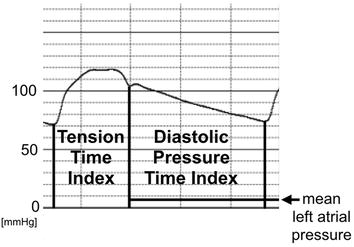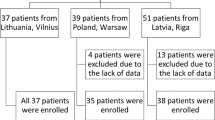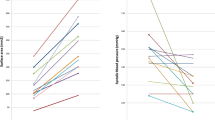Abstract
Complications, such as recoarctation or secondary hypertension, probably related to the loss of arterial elasticity, frequently occur after aortic coarctation surgery. This study aimed to investigate arterial compliance as evaluated by automated recording of the QKd interval in patients who underwent repair of coarctation by construction of a subclavian flap compared with those who underwent resection of the narrowed aortic segment with end-to-end anastomosis. Thirty-nine children who underwent surgical repair of aortic coarctation by subclavian flap (n = 19) and by end-to-end anastomosis (n = 20) were enrolled. Arterial stiffness was measured by the noninvasive QKd 100-60 method. Twenty-four–hour ambulatory blood pressure monitoring and a transthoracic echocardiography were also performed. The group of patients who had an end-to-end anastomosis showed better results regarding 24-hour blood pressure profile and QKD 100-60 value compared with those underwent construction of a subclavian flap. Surgical repair of aortic obstruction by end-to-end anastomosis demonstrates better preservation of arterial distensibility than those repaired by subclavian flap. Therefore, it appears to be advantageous, whenever possible, to use the end-end anastomosis approach, which appears to lessen the incidence of the most common complications after aortic arch surgery.
Similar content being viewed by others
References
Anderson RH, Macartney FJ (2002) Paediatric cardiology, 2nd edn. Churchill Livingstone, London, England, pp 1523–1557
Benetos A, Laurent S, Asmar RG, Lacolley P (1997) Large artery stiffness in hypertension. J Hypertens 15(Suppl 2):89–97
Clark JA, Lieh-Lai MW, Sarnaik A, Mattoo TK (2002) Discrepancies between direct and indirect blood pressure measurements using various recommendations for arm cuff selection. Pediatrics 110:920–923
Devereux RB, Reichek N (1977) Echocardiographic determination of left ventricular mass in man. Anatomic validation of the method. Circulation 55:613–618
Elzenga NJ, Gittenberger-de Groot AC, Oppenheimer-Dekker A (1986) Coarctation and other obstructive aortic arch anomalies: their relationship to the ductus arteriosus. Int J Cardiol 13:289–308
Giordano U, Giannico S, Turchetta A, Hammad F, Calzolari F, Calzolari A (2005) The influence of different surgical procedures on hypertension after repair of coarctation. Cardiol Young 15:477–480
Giordano U, Turchetta A, Calzolari F, Crosio G, Giannico S, Calzolari A (2003) Exercise blood pressure response, cardiac output and 24-hour ambulatory blood pressure monitoring in children after aortic coarctation repair. Ital Heart J 4:408–412
Gosse P, Braunstein C, Clementy J (1996) Beyond blood pressure measurements: monitoring of the appearance time of Korotkoff sounds. Blood Press Monit 1:193–195
Gosse P, Gasparoux P, Ansoborlo P, Lemetayer P, Clementy J (1997) Prognostic value of ambulatory measurement of the timing of Korotkoff sounds in elderly hypertensives: a pilot study. Am J Hypertens 10:552–557
Gosse P, Guillo P, Ascher G, Clementy J (1994) Assessment of arterial distensibility by monitoring the timing of Korotkoff sounds. Am J Hypertens 7:228–233
Gosse P, Jullien V, Lemetayer P, Jarnier P, Clementy J (1999) Ambulatory measurement of the timing of Korotkoff sounds in a group of normal subjects: influence of age and height. Am J Hypertens 12:231–235
Guèrin P, Jimenez M, Vallot M, Thambo JB, Gosse P (2005) Arterial rigidity of patients operated successfully for coarctation of the aorta without residual hypertension. Arch Mal Coeur Vaiss 98:557–560
Ho SY, Anderson RH (1979) Coarctation, tubular hypoplasia and the ductus arteriosus. Histological study of 35 specimens. Br Heart J 41:268–274
Ho SY, Somerville J, Yip WC, Anderson RH (1988) Transluminal balloon dilation of resected coarcted segments of thoracic aorta: histological study and clinical implications. Int J Cardiol 19:99–105
Isner JM, Donaldson RF, Fulton D, Bhan I, Payne DD, Cleveland RJ (1987) Cystic medial necrosis in coarctation of the aorta: a potential factor contributing to adverse consequences observed after percutaneous balloon angioplasty of coarctation sites. Circulation 75:689–695
Keane JF, Fyler DC (2006) Nadas’ pediatric cardiology, 2nd edn. W. B. Saunders Company, Philadelphia, PA, pp 627–644
Ong CM, Canter CE, Gutierrez FR, Sekarski DR, Goldring DR (1992) Increased stiffness and persistent narrowing of the aorta after successful repair of coarctation of the aorta: relationship to left ventricular mass and blood pressure at rest and with exercise. Am Heart J 123:1594–1600
Report of the Second Task Force on Blood Pressure Control in Children (1987) Task force on blood pressure control in children. National Heart, Lung, and Blood Institute, Bethesda, Maryland. Pediatrics 79:1–25
Russell GA, Berry PJ, Watterson K, Dhasmana JP, Wisheart JD (1991) Patterns of ductal tissue in coarctation of the aorta in the first three months of life. J Thorac Cardiovasc Surg 102:596–601
Sehested J, Baandrup U, Mikkelsen E (1982) Different reactivity and structure of the prestenotic and poststenotic aorta in human coarctation. Implications for baroreceptor function. Circulation 65:1060–1065
Wallentin I, Hanson E, Eriksson BO (1988) Non-invasive evaluation of the long-term results of coartectomy in childhood. Clin Physiol 8:121–128
Author information
Authors and Affiliations
Corresponding author
Rights and permissions
About this article
Cite this article
Bassareo, P.P., Marras, A.R., Manai, M.E. et al. The Influence of Different Surgical Approaches on Arterial Rigidity in Children After Aortic Coarctation Repair. Pediatr Cardiol 30, 414–418 (2009). https://doi.org/10.1007/s00246-008-9381-2
Received:
Revised:
Accepted:
Published:
Issue Date:
DOI: https://doi.org/10.1007/s00246-008-9381-2




